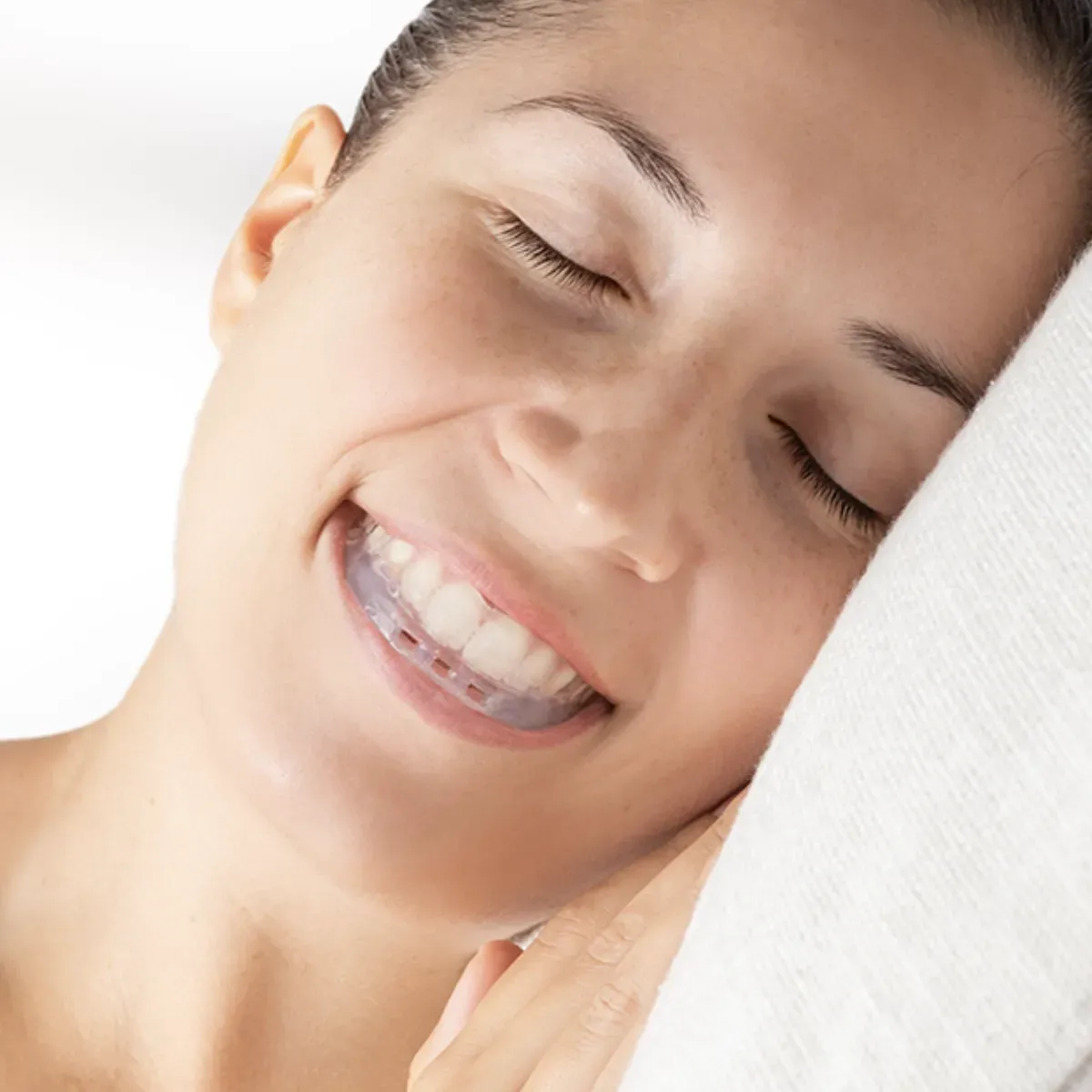Brandon Boggan has been practicing orthodontics full-time since 1998. He is the Chief Smile Engineer and the CFO (Chief Fun Officer) at Ortho South in Pelham and Calera, Alabama. His love for people, marketing, and helping other orthodontists grow their practice led him to start a brand and website development and digital marketing company called Onboard Marketing Group. You can find Brandon on LinkedIn, OrthoSouth.com, or OnboardMG.com.
Sleep Apnea: A Comprehensive Guide to Understanding, Managing, and Living Better

By Dr. Brandon Boggan
Share This

Introduction
Sleep apnea is a prevalent sleep disorder with far-reaching consequences. Dr. Brandon Boggan and Dr. Zehra Syed at Ortho South recognize the critical need to address this condition due to its high prevalence and the significant impact it can have on individuals' health. This comprehensive guide delves into the intricate details of sleep apnea, aiming to provide valuable insights and practical tips for managing this condition effectively.
Types of Sleep Apnea
Obstructive Sleep Apnea (OSA)
1. Explanation of OSA
Obstructive Sleep Apnea (OSA) is a disorder characterized by the repeated obstruction of the upper airway during sleep, leading to breathing pauses. The blockage typically occurs when the soft tissue at the back of the throat collapses and closes during sleep.
2. Common symptoms
Common symptoms of OSA include loud snoring, abrupt awakenings accompanied by a choking or gasping sound, and excessive daytime sleepiness. Recognizing these signs early is crucial for timely intervention.
Central Sleep Apnea (CSA)
1. Overview of CSA
Central Sleep Apnea (CSA) differs from OSA as it involves a failure of the brain to send the appropriate signals to the muscles to initiate breathing. This type is less common but equally impactful.
2. Differentiating CSA from OSA
Distinguishing CSA from OSA is essential for accurate diagnosis and tailored treatment. CSA is often associated with medical conditions affecting the brainstem, such as neurological diseases.
Complex Sleep Apnea Syndrome (CompSAS)
1. Definition of CompSAS
Complex Sleep Apnea Syndrome (CompSAS) combines OSA and CSA elements. Individuals with CompSAS exhibit characteristics of both types, presenting unique diagnosis and treatment planning challenges.
2. Identifying characteristics
Identifying specific characteristics, such as persistent symptoms despite continuous positive airway pressure (CPAP) therapy, helps healthcare professionals tailor effective interventions.
Causes of Sleep Apnea
Physical factors
1. Obesity and its impact
Obesity significantly increases the risk of sleep apnea, as excess weight can accumulate fatty deposits around the neck, contributing to airway obstruction.
2. Airway abnormalities
Certain physical attributes, such as a narrow airway, may predispose individuals to sleep apnea. Understanding these factors is crucial for a targeted approach to treatment.
Medical conditions
1. Hypertension and sleep apnea connection
There is a strong correlation between sleep apnea and hypertension. The intermittent oxygen deprivation associated with sleep apnea can elevate blood pressure, emphasizing the need for comprehensive management.
2. Diabetes and its correlation
Sleep apnea has also been linked to diabetes, highlighting the importance of addressing sleep disorders in individuals with existing metabolic conditions.
Diagnosis and Testing
Importance of early detection
Early detection of sleep apnea is paramount to prevent complications and enhance overall well-being. Timely diagnosis allows for the implementation of effective treatment strategies.
Common diagnostic methods
1. Polysomnography
Polysomnography, a sleep study conducted in a controlled environment, monitors various parameters such as brain activity, eye movement, heart rate, and respiratory effort. It is a gold standard for diagnosing sleep apnea.
2. Home sleep apnea testing
For more accessible and convenient diagnostics, home sleep apnea testing provides an alternative. It involves using portable monitoring devices to assess key indicators while individuals sleep in their beds.
Treatment Options
Lifestyle changes
1. Weight management
Weight management plays a pivotal role in managing sleep apnea, especially in cases where obesity is a contributing factor. Adopting a healthy lifestyle with regular exercise and a balanced diet is essential.
2. Positional therapy
For individuals with positional sleep apnea, altering sleeping positions can significantly improve symptoms. Sleeping on the side rather than the back may prevent airway obstruction.
Continuous Positive Airway Pressure (CPAP)
1. Explanation of CPAP
CPAP is a widely used treatment method involving a machine that delivers a continuous air stream through a mask, preventing airway collapse during sleep.
2. Benefits and challenges
While CPAP is highly effective, adherence can be challenging for some individuals. Understanding both the benefits and potential challenges is crucial for successful implementation.
Bi-level Positive Airway Pressure (BiPAP) Therapy
1. Explanation of BiPAP
For those who find CPAP uncomfortable, especially individuals with CSA, Bi-level Positive Airway Pressure (BiPAP) Therapy offers variable pressure levels.
2. Benefits
This dual-pressure approach supports inhalation and exhalation, enhancing comfort and compliance for patients with varying needs.
Cutting-Edge Orthodontic Solutions Integrated with Oral Appliance Therapy
1. Orthodontic Mastery: A Comprehensive Approach
- Braces and Aligners (e.g., Invisalign):
Braces and Invisalign, not only brings orthodontic innovation, but perfects smiles and optimizes jaw alignment, fostering superior airflow during sleep. - Rapid Palatal Expander:
Rapid Palatal Expanders focus on expanding (or widening) the upper jaw, addressing airway obstruction concerns for enhanced breathing during sleep. - Oral Appliance Therapy (e.g., MADs):
Mandibular Advancement Devices (MADs) represent non-invasive excellence, expertly repositioning the jaw to maintain an open airway, offering an effective and comfortable alternative. - These solutions epitomize precision, innovation, and patient-centric care in the realm of orthodontics and sleep medicine synergy. This integration signifies the evolution of holistic healthcare practices.
2. Surgical Interventions
Uvulopalatopharyngoplasty (UPPP):
- UPPP involves the removal of excess tissue to widen the airway, promoting improved breathing.
Inspire Surgery (Upper Airway Stimulation - Hypoglossal Nerve Stimulation):
- Inspire Surgery utilizes a small implantable device to stimulate throat muscles, preventing airway collapse during sleep. It represents an innovative surgical option for select cases.
3. Orthodontic and Surgical Combination
Maxillomandibular Advancement (MMA) with braces or aligners (like Invisalign):
- The combined approach of orthodontic and surgical methods, such as MMA with braces or aligners, showcases enhanced treatment effectiveness. This procedure is incredibly effective for many patients.
Lifestyle Tips for Managing Sleep Apnea
Living with sleep apnea necessitates strategic lifestyle adjustments. These tips can significantly improve sleep quality and overall well-being.
Sleep hygiene practices
1. Consistent sleep schedule
Maintaining a consistent sleep schedule by going to bed and waking up at the same time each day helps regulate the body's internal clock, promoting better sleep quality.
2. Creating a conducive sleep environment
Ensuring the bedroom is dark, quiet, and cool contributes to optimal sleep conditions. Simple adjustments, such as using blackout curtains and white noise machines, can make a significant difference.
Dietary recommendations
1. Impact of diet on sleep apnea
Understanding the impact of diet on sleep apnea is essential. Certain foods, like heavy meals and caffeine, can exacerbate symptoms, while a balanced diet supports overall health.
2. Foods to avoid and include
- Foods to avoid:
- Heavy and spicy meals close to bedtime.
- Caffeine and alcohol consumption before sleep.
- Foods to include:
- Foods rich in magnesium and melatonin include nuts, seeds, and certain fruits.
The Link Between Sleep Apnea and Mental Health
Impact on mental well-being
Sleep apnea not only affects physical health but also significantly impacts mental well-being. The intermittent disruptions in sleep patterns can lead to mood swings, anxiety, and depression.
Strategies for managing mental health alongside sleep apnea
Incorporating mindfulness practices and relaxation techniques, such as meditation and deep breathing exercises, can help manage stress and promote mental well-being.
Sleep Apnea in Children
Recognizing sleep apnea in kids
Recognizing sleep apnea in children is crucial for early intervention. Common signs include restless sleep, frequent snoring, and observed pauses in breathing.
Treatment approaches for pediatric sleep apnea
Consulting pediatric specialists is essential for tailored treatment approaches in children. Treatment may involve lifestyle modifications, orthodontic interventions, or surgical options, depending on the severity.
Seeking Professional Help
Importance of consulting a healthcare professional
The guidance of a healthcare professional is paramount for accurate diagnosis and effective treatment. Sleep specialists, pulmonologists, or otolaryngologists can provide tailored approaches based on individual needs.
Choosing the right specialist
Selecting the appropriate healthcare provider ensures comprehensive care. Considering factors such as expertise in sleep medicine or otolaryngology helps individuals make informed choices.
FAQs
- What are the main symptoms of sleep apnea?
Common symptoms include loud snoring, choking or gasping during sleep, and daytime fatigue. Early recognition of these symptoms is crucial for timely intervention. - How is sleep apnea diagnosed?
Diagnosis involves sleep studies, with polysomnography being the gold standard. Home sleep apnea testing provides a convenient alternative for some individuals. - Are there natural remedies for managing sleep apnea?
Lifestyle changes, such as weight management and positional therapy, can be natural remedies for managing sleep apnea. These approaches complement medical interventions. - Can children outgrow sleep apnea?
While some children may outgrow sleep apnea, early intervention remains essential for positive outcomes. Monitoring and appropriate treatment ensure optimal health in the long run. Maxillary and expansion (along with mandibular width correction) can significantly increase the amount of airflow and decrease the incidence of apnea and hypopnea. - What are the long-term consequences of untreated sleep apnea?
Untreated sleep apnea can lead to severe health issues, including cardiovascular problems, diabetes, and mental health concerns. Seeking timely treatment is crucial for preventing these consequences.
Conclusion
In conclusion, understanding and managing sleep apnea is crucial to enhancing overall health and well-being. Sleep apnea, a multifaceted disorder with various contributing factors, requires a comprehensive approach for effective management. From lifestyle adjustments and innovative treatment options to recognizing the interplay between sleep apnea and mental health, this guide has aimed to provide a thorough understanding.
As we navigate the diverse landscape of sleep apnea, it becomes evident that early detection, accurate diagnosis, and personalized treatment plans are pivotal. From the array of treatment options, including lifestyle modifications, continuous positive airway pressure (CPAP), bi-level positive airway pressure (Bi-PAP), orthodontic solutions including braces, Invisalign, clear aligner therapy, oral appliance therapy like MADs (mandibular advancement devices), surgical interventions including maxillary and mandibular advancement surgery, or a combination of these approaches, individuals can find tailored strategies that align with their unique needs.
In your journey with sleep apnea, seeking professional help from healthcare providers specializing in sleep medicine, pulmonology, or otolaryngology is paramount. The right specialist can guide you towards an accurate diagnosis and a comprehensive treatment plan, ensuring the best possible outcomes.
Remember, managing sleep apnea is a collaborative effort involving individuals, healthcare professionals, and support networks. By staying informed, making proactive lifestyle choices, and seeking timely assistance, individuals can take significant strides toward living a healthier and more fulfilling life.












